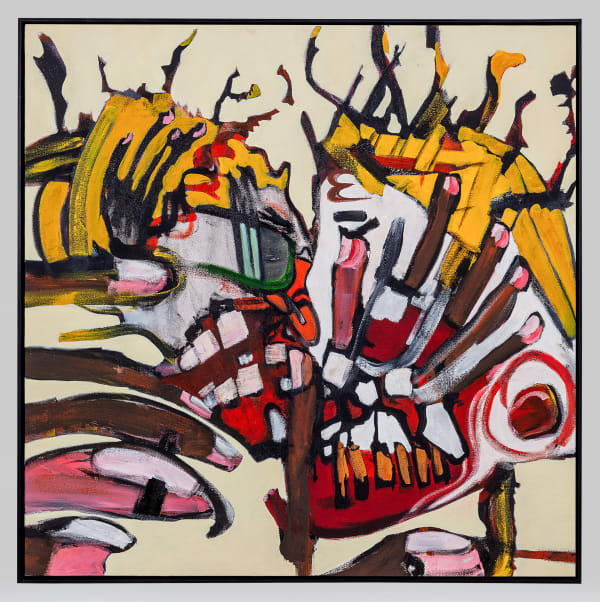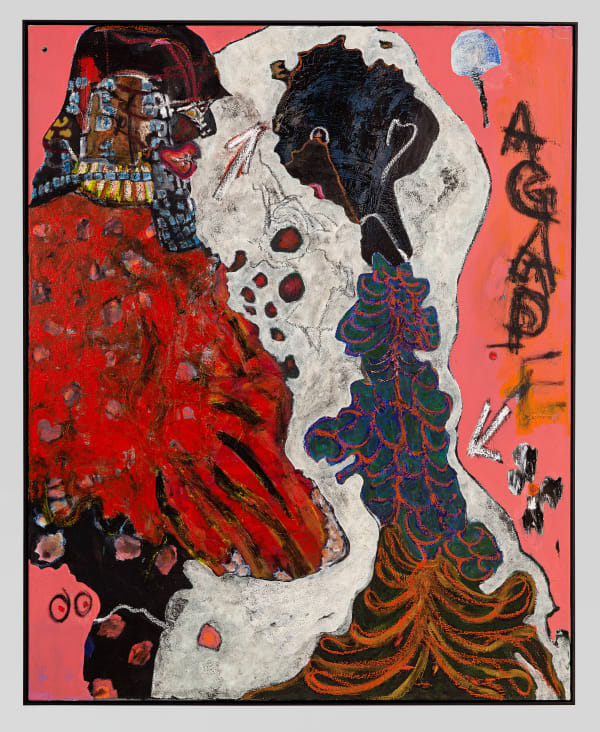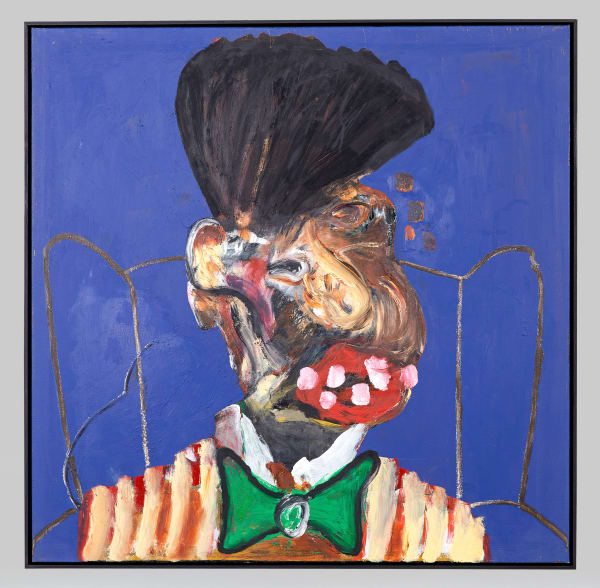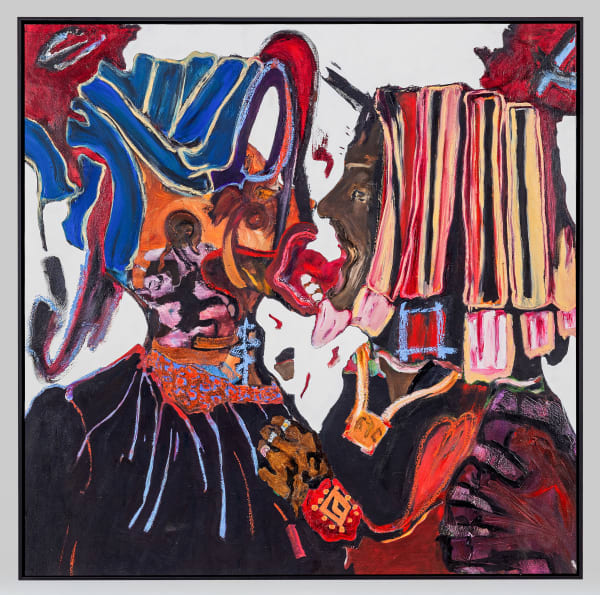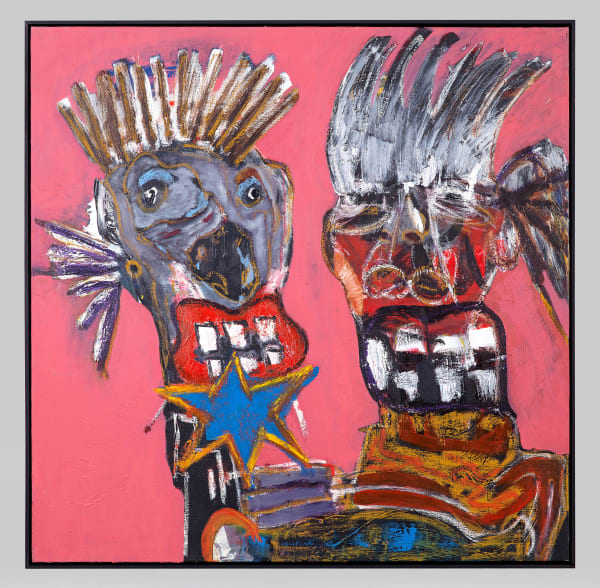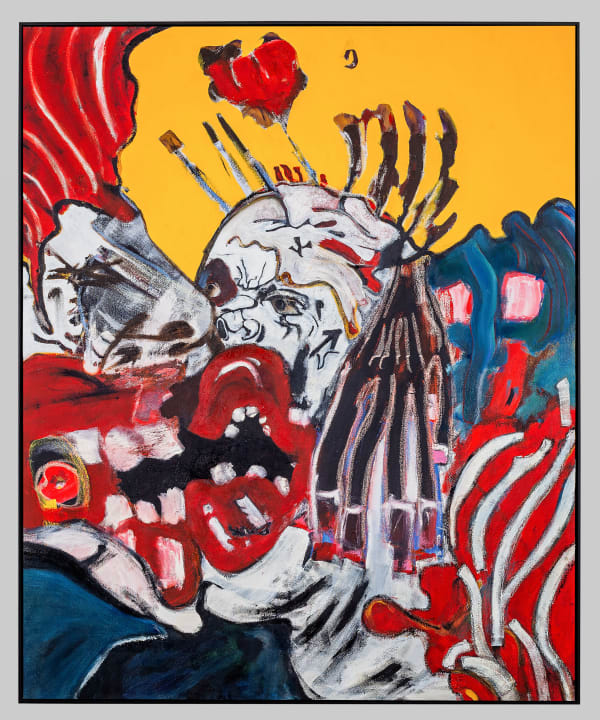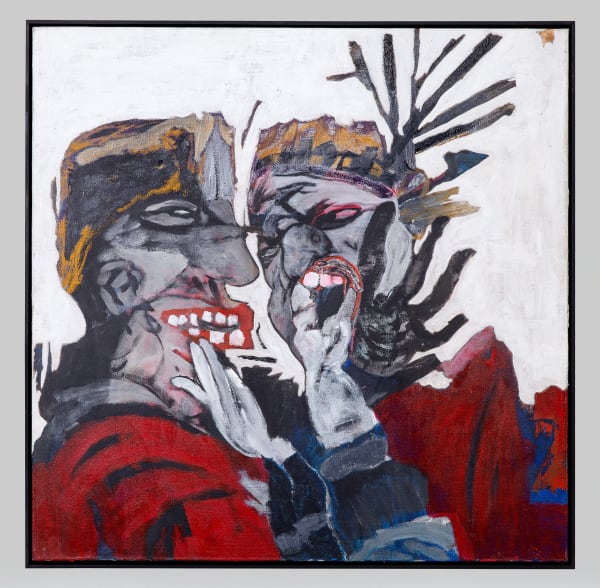BRUTAL EXPRESSIONISM AND CYRILLE CHAMAYOU’S L’AMOUR FOU
Curated by Candice Berman
March 2024
In the space between stimulus and integration lies a no-man’s land of internal processing that exceeds the limitations of logic, language and constructed meaning. It is a vast inner landscape where time loses structure and the wordless, visceral experience of confronting, feeling and responding supersedes all. It is in this space of “no territory” where Chamayou’s art is born. His work follows the style of no style, echoing the essence of Brutalism, which, as Alison and Peter Smithson described it, “tries to face up to a mass-produced society and drag a rough poetry out of the confused and powerful forces which are at work” – Chamayou’s process leans so much towards catharsis and intimate, personal ritual that he struggles to view himself or be labelled as an artist, preferring instead to only go by his first name, Cyrille.
Chamayou describes his art practice as slow, and his painting as fast. In his Brutal Expressionism, the artist deliberately enters a mental domain where he often encounters fear, a certain loss of control, engaging with his thoughts, emotions and materials with a degree of violence, a ruthless uncovering of the work from the rawness of experience: “I have no plan when I paint. I start with some random shapes and collage to start with faces and representation. Most of it ends with nothing that it started with. When I start to paint, I know that I don't really know how to paint, I don’t know where I am going. Every time I finish a painting and I look at it, I think, how have I done that? Will I be able to do it again? I know that I don’t know how to paint that, but I did it. And when you look at the series, the proof is that I do it again. When I complete a work I am relieved, but also panicked, because I don’t know if i will be able to do it again.”
This intentional engagement with uncertainty, the relinquishment of any attachment to the outcome of the process or the final piece, brings an energy of cathartic intensity to Chamayou’s artmaking, his brushstrokes almost vibrating with the passion of their creation. The raw and somewhat discomfiting images that result embody the hallmarks of Brutal Expressionism, a contemporary art movement that is arising in response to the current, collective planetary environment, where chaos and unpredictability seem more actual and intimidating than ever. Brutal Expressionism allows space for art to become purgative – for the artist in its creation, but also for the viewer in encountering the final piece.
In Chamayou’s series, L’amour Fou, he grapples with cycles of love: “When we meet, we love each other, we tear each other apart, we fight, we start again”. This duality is clear in the works, each of which elicits an emotional, often unsettling reaction in the viewer, oscillating between opposing interpretations, straddling the borders between good and bad, violence and passion, brutal love and loving brutality. Conveying a precise message or relaying an image that is simple to interpret is not the goal of Brutal Expressionism, however. Rather, it aims to make its audience think and feel from different perspectives, allowing room for novel significance to emerge. In the words of André Breton, for whose book Chamayou’s series is named: “What is strangest is inseparable from love, presiding over its revelation in individual as well as in collective terms”.
Chamayou carries an awareness of this strange interplay between the personal and the public, not only in his own work, but also in fine art more generally: “Art is the only cultural product that is not influenced by masses of people. We buy millions of records, thousands of people attend a show, we all watch the same movies and series and we have an influence on what is sold to us. But art is less influenced by its audience and more influenced by the artist. Artists do reference themselves or each other, but art needs to be unique, it needs to come from the soul in the end”. This juxtaposition between personal meaning and how that may be interpreted or understood by an unknown other is a challenge that Brutal Expressionism confronts head-on, abandoning the safe boundaries of style or determined outcome in favour of authentic creation.
For the upcoming exhibition of L’amour Fou, Chamayou’s work will be underscored by an accompanying musical playlist elaborating on the progression of the journey of love. This is put together by South African-born artist and music producer Cameron Davidson, whose constant search for musical ideas to inspire and connect with his audience are partly built and designed by his previous life experiences. This personal expression enables his audience to immerse themselves in his music, enabling Davidson to bridge the gaps between inspiration, creation, and connection through music.
-
 Cyrille Chamayou(untitled #29), 2024Acrylic and oil on canvas100 x 100 cm
Cyrille Chamayou(untitled #29), 2024Acrylic and oil on canvas100 x 100 cm
framed 102 x 102 x 5 cm -
 Cyrille ChamayouAgape , 2023Acrylic and oil on canvas152 x 122 cm
Cyrille ChamayouAgape , 2023Acrylic and oil on canvas152 x 122 cm
framed 154 x 124 x 5cm -
 Cyrille ChamayouMy hands on your trigger, 2024Acrylic and oil on canvas150 x 150 cm
Cyrille ChamayouMy hands on your trigger, 2024Acrylic and oil on canvas150 x 150 cm
framed 152 x 152 x 5 cm -
 Cyrille Chamayou(untitled #24), 2024Acrylic and oil on canvas152 x 91 cm
Cyrille Chamayou(untitled #24), 2024Acrylic and oil on canvas152 x 91 cm
framed 154 x 93 x 5 cm -
 Cyrille Chamayou(untitled #10), 2023Acrylic and oil on canvas120 x 120 cm
Cyrille Chamayou(untitled #10), 2023Acrylic and oil on canvas120 x 120 cm
framed 122 x 122 x 5 cm -
 Cyrille ChamayouShe, 2024Acrylic and oil on canvas122 x 122 cm
Cyrille ChamayouShe, 2024Acrylic and oil on canvas122 x 122 cm
framed 124 x 124 x 5 cm -
 Cyrille Chamayou(untitled #23), 2024Acrylic and oil on canvas150 x 150 cm
Cyrille Chamayou(untitled #23), 2024Acrylic and oil on canvas150 x 150 cm
framed 152 x 152 x 5 cm -
 Cyrille Chamayou(untitled #15), 2023Acrylic and oil on canvas91 x 91 cm
Cyrille Chamayou(untitled #15), 2023Acrylic and oil on canvas91 x 91 cm
framed 94 x 94 x 5cm -
 Cyrille Chamayou(untitled #1), 2023Mixed media on canvas101.5 x 101.5cm
Cyrille Chamayou(untitled #1), 2023Mixed media on canvas101.5 x 101.5cm
framed 104 x 104 x 5cm -
 Cyrille Chamayou(untitled #17), 2023Acrylic and oil on canvas91 x 91 cm
Cyrille Chamayou(untitled #17), 2023Acrylic and oil on canvas91 x 91 cm
framed 104 x 104 x 5 cm -
 Cyrille Chamayou(untitled #16), 2023Acrylic and oil on canvas91 x 91 cm
Cyrille Chamayou(untitled #16), 2023Acrylic and oil on canvas91 x 91 cm
framed 94 x 94 x 5cm -
 Cyrille Chamayou(untitled #19), 2024Acrylic and oil on canvas101 x 101 cm
Cyrille Chamayou(untitled #19), 2024Acrylic and oil on canvas101 x 101 cm
framed 103 x 103 x 5 cm -
 Cyrille Chamayou(untitled #5), 2023Acrylic and oil on canvas120 x 120 cm
Cyrille Chamayou(untitled #5), 2023Acrylic and oil on canvas120 x 120 cm
framed 122 x 122 x 5 cm -
 Cyrille ChamayouA Timeless Celebration of Love, 2023Acrylic and oil on canvas91 x 91 cm
Cyrille ChamayouA Timeless Celebration of Love, 2023Acrylic and oil on canvas91 x 91 cm
framed 94 x 94 x 5cm -
 Cyrille Chamayou(untitled #18), 2023Acrylic and oil on canvas152 x 122 cm
Cyrille Chamayou(untitled #18), 2023Acrylic and oil on canvas152 x 122 cm
framed 154 x 124 x 5 cm -
 Cyrille Chamayou(untitled #12), 2023Acrylic and oil on canvas91 x 91 cm
Cyrille Chamayou(untitled #12), 2023Acrylic and oil on canvas91 x 91 cm
framed 94 x 94 x 5cm -
 Cyrille Chamayou(untitled #13), 2023Acrylic and oil on canvas120 x 120 cm
Cyrille Chamayou(untitled #13), 2023Acrylic and oil on canvas120 x 120 cm
framed 122 x 122 x 5 cm -
 Cyrille Chamayou(untitled #21), 2024Acrylic and oil on canvas150 x 120 cm
Cyrille Chamayou(untitled #21), 2024Acrylic and oil on canvas150 x 120 cm
framed 152 x 122 x 5 cm -
 Cyrille Chamayou(untitled #11), 2023Acrylic and oil on canvas91 x 91 cm
Cyrille Chamayou(untitled #11), 2023Acrylic and oil on canvas91 x 91 cm
framed 94 x 94 x 5cm -
 Cyrille Chamayou(untitled #9), 2023Acrylic and oil on canvas91 x 91 cm
Cyrille Chamayou(untitled #9), 2023Acrylic and oil on canvas91 x 91 cm
framed 94 x 94 x 5cm -
 Cyrille ChamayouThe Time of Joy Was Well and Truly Over for Them, 2023Acrylic and oil on canvas101 x 101 cm
Cyrille ChamayouThe Time of Joy Was Well and Truly Over for Them, 2023Acrylic and oil on canvas101 x 101 cm
104 x 104 x 5cm -
 Cyrille Chamayou(untitled #3), 2023Acrylic and oil on canvas91 x 91 cm
Cyrille Chamayou(untitled #3), 2023Acrylic and oil on canvas91 x 91 cm
framed 94 x 94 x 5cm
